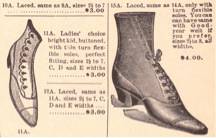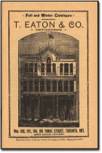In 1884, just as this part of Manitoba was filling up with settlers, Eaton’s published their first Mail Order Catalogue. It was the start of a fondly remembered relationship.
Those first black & white, text-only, catalogues offered mainly clothing but the options soon included everything from books to furniture and farm tools. By the 1890’s they had established themselves across the prairies.

In today’s world of gigantic shopping malls and big-box superstores offering an endless variety of goods, we might fail to appreciate how the Eaton’s catalogue opened up a world of choice to an isolated farm family.
The subsistence lifestyle that settlers faced in those first years was always a means to an end and never and end in itself. They came to start a new life. They were prepared to endure hard work and face some lean years. But the goal was a better life than what they had left behind. The acquisition of consumer goods - fashions, furnishings, and personal products that symbolized a better life - was a dream deferred but never abandoned. When they found themselves ready to avail themselves of some of the fruits of their labours, many households were over fifteen kilometres from the nearest store, and it wasn’t a trip they would make often, especially in the winter. The impact of the Eaton’s Catalogue on the lives of farm families is hard to overstate.
By 1893 the offerings included: dress materials such as French cashmere, silk blouses with leg-o'-mutton sleeves, straw hats trimmed with ostrich plumes and lace, a man's blue serge suit priced at $3.00, parlor sofas and settees, picture-easels, and complete sets of the works of Dickens, Macaulay and Kipling. The Eaton's catalogues from that day on were eagerly sought as a means of keeping abreast of the fashions in clothes, furnishings and reading matter, and were used as well to prove to local merchants that local prices were subject to competition and should be reduced.

Orders went to Toronto until the Winnipeg Store opened in 1905. They eventually opened catalogue order offices in local businesses, as Sears does to this day. One interesting feature was the Groceteria Catologue, which featured very popular lines of jams, dried fruits and biscuits. And just to cover all the bases, the first bell for the Butterfield School was … you guessed it… from Eaton’s!
They even developed a line of ready-to assemble houses.
Serious efforts we made to get involved and give something back to the communities that had allowed the business to flourish. They offered prizes for various cultural competitions and gifts to community endeavours. For example, in the thirties Eaton’s supplied a free twenty-five pound pail of hard candy for each school that made a request - for the Christmas Concert.
Of course local businesses were not happy about the competition. In the early days Eaton’s was providing things that local merchants would not find feasible, or even possible, to stock. But that changed when Eaton’s ready-made clothing began to compete effectively with the work of the dressmakers, as well as with the sale of most other articles offered by local storekeepers. So in an inevitable way, Eaton’s was a first step away from those early days when shopping locally was the only option.
. . . . .
Author: Ken Storie
Sources:
Edward History Book Committee. Harvests of Time. Altona. Friesen Printers, 2003 Melita - Arthur History Committee. Melita: Our First Century. Altona. Friesen Printers, 1983 Parkinson, Hazel McDonald . The Mere Living, A Biography of the Hartney District. Altona. D.W. Friesen & Sons Ltd.1957 Personal Recollections: Jane Manshreck, Sid Ransom
Note of interest: Eaton’s sold a house and barn to a man at Regent and he then married the salesgirl that sold them to him.
